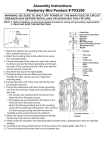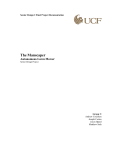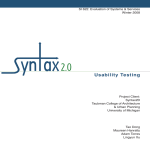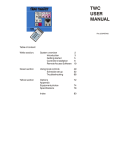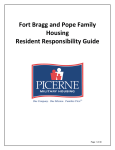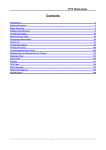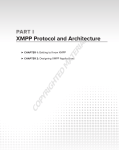Download Pemberley Home Owners Board of Directors Meeting
Transcript
Pemberley Home Owners Board of Directors Meeting Meeting Minutes January 29, 2008 7:00pm Meeting Location: Pemberley Clubhouse Meeting Facilitator: Duane Day Meeting Minutes: Duane Day Attendees: Duane Day, Jason Skinrood, Joe Anderson, Jennifer Casabar, Jeremy Mclerran (arrived about an hour into the meeting), Jason Sucher The meeting was called to order at 7:15 by Duane Day. Minutes from the last monthly board meeting in Nov 2007 were previously approved by email vote. Joe Anderson and Duane Day voted to approve the minutes, Jennifer Casabar & Jeremy McLerran (who authored the minutes) did not vote. Jason Skinrood abstained because he was not at the November meeting. Motion carried on Jan 3, 2008. Official Business conducted since the last meeting The board resolution "Notification of Condo Rental" was approved via email vote on Jan 3-4. Joe Anderson, Jeremy McLerran, and Duane Day voted in favor of the resolution. Jason Skinrood and Jennifer Casabar did not vote. Community Input Period Rod Peterson asked if we could get a wastebasket in the workout room for paper towels people have used to clean off the equipment. Joe's agreed to get something for in there. Rod also asked if anything had been done about getting a crosswalk in front of the community for schoolkids who are crossing the street to catch the bus. Duane had taken it as an action item after the last meeting to ask the city about a crosswalk, but because of the whole water bill situation he hadn't done so yet (the City Public Works department kind of feels attacked by our attempts to get our back water bill charges reduced). We decided to ask Rick Ables, our newly appointed neighborhood chair for the city's Neighborhood Advisory Board, to approach the city about a crosswalk. Brent Ramey asked about getting the light bulb in front of his house replaced. Jason Sucher will contact Shane and ask him to walk through the neighborhood and replace lights at the Ramey's and everywhere they're out. Ron and Mary Peterson pointed out that the cold weather has brought an extra amount of dog poop not being picked up. Sarah Larsen and others mentioned that there is a significant problem with Rockwell residents not picking up after their dogs in Pemberley. Jason Sucher took down a few names and will be contacting people in Rockwell who are violating the rules. Jason Sucher will write up a newsletter article reminding people of the dog poop rules in Pemberley and letting people know that they can report Rockwell residents to Advantage Management. Banning Stephens asked if we are planning to install dog poop stations with little baggies. He and Joe are going to look into the possibility of purchasing those stations from PetSmart for $75 a piece, and they're going to explore what kind of deal we can get on an underground shock collar fence around the large grassy area on the South side of the community. Regular cost of materials for a fence that size is approximately $200. Mary Peterson asked if we would be willing to reimburse Rudy Benoit, an artist who lives in Pemberley, for his supplies if he paints something to hang in the clubhouse. Some of our artwork was stolen recently and she feels it would be great to have him paint something instead of just buying something from an art store. She has already talked to him and he's agreed to do it, we just need to approve the funds. The board was more than willing to allow Rudy's art to hang in the clubhouse and Mary will tell him to contact us to let us know approximately how much money he needs to purchase art materials. Activities Children's Activities this Saturday - There was not much to report about the activity this Saturday other than to repeat that it starts at 10:30am in the clubhouse and that it will be a magic show for kids. Unfortunately the funeral broadcast for Gordon B. Hinckley starts at 11:00am that day, but the activity has already been rescheduled once and we don't want to do it again. Upcoming Activities: The next activity will be the Annual Easter Egg hunt the Saturday before Easter (March 22). Joe reminded Jennifer that there are still buckets of plastic eggs left over from last year's hunt and they are stored in the clubhouse. Activities Budget use approval process: The board briefly discussed the use of funds by the Jennifer and the Activities committee. We agreed that they don't need to get approval for the budget of each individual activity. They have an annual budget and should not go over that budget without prior board approval. Communications Because Jeremy McLerran, the board member in charge of Communications, had not yet arrived we tabled discussion of Communications until later in the meeting. Community & Government Affairs City Water Bill update: It's been well-publicized to the community that Pleasant Grove City is attempting to collect approximately $168,000 in back water bills from the HOA. Joe Anderson gave a brief summary of the meeting he, Jason Sucher, and Duane Day had with the Pleasant Grove City Administrator, Frank Mills, about the situation earlier this month. After meeting with the City Council earlier this month to describe what was going on and appeal to them for help, we met with Frank Mills to assist him in conducting an investigation. We described to him how the HOA billing works and what facts we know about our bills. We learned from Frank that although the developers had set the meters properly, somehow our meters were never registered with the city and so weren't being read along with the other meters in the neighborhood by the city's meter readers. That's why we weren't being billed for some buildings. It was asked what the board plans to do from here. Duane called Frank earlier today and found out that he is still waiting for more information from other members of the city staff, but he expects to have an update later this week. We expect to meet with him at least once more and for a final resolution to come from him in a few weeks. If we are not satisfied with Frank's resolution, we will appeal to the City Council and ultimately sue the city if we are still not satisfied. However, we believe Frank and the other people in charge of the city are honest and fair and so we have confidence that we'll find a satisfactory resolution to the problem without going to court. Neighborhood Chair - Rick Ables: We again briefly discussed that Rick Ables, a community member who last year unsuccessfully campaigned for an open position on the city council, has been recently appointed as the neighborhood chair for the entire Grove area. He has already petitioned the city to fix a street light in front of Pemberley and will be asking them to consider installing a traffic light on the intersection of Pleasant Grove Boulevard and 1300 W (something we have wanted for a long time). The city has also asked him to review plans for development going on near us and to give feedback on the impact to us and other residents living in the area. We plan to continue to ask him to help us in matters that involve the city government. PG downtown development proposal: An organization within Pleasant Grove opposed to a proposed development downtown has asked Duane to forward information about the development to our residents and about public meetings being held to decide on zoning for the new development, etc. Duane asked the board if they felt passing this kind of information along would be appropriate since we've never really informed our residents about public meetings in the past and so it might give the impression that we as a board oppose the development. Joe said he felt like giving residents information like this was entirely appropriate and Duane took it as an action item to put something about it on the HOA website. Jason Sucher agreed and pointed out that Gateway Village has sent similar information around to their residents. Proposed bylaw amendment restricting the total number of rentals in Pemberley: At the November board meeting this proposed amendment was discussed and Joe Anderson took it as an action item to make some revisions to the proposed bylaw wording. He did so and emailed the amended proposal to the entire board in early December. However, Joe had a question about whether the amendment ought to include wording allowing the board to revoke a homeowner's right to rent a unit, and Jeremy McLerran had some additional concerns about the amendment that needed discussion before the board felt prepared to take a final vote on whether to approve the proposed amendment for a neighborhood vote. The first topic discussed was paragraph i of the latest draft of the proposed amendment: "Permission to rent a Unit, once granted by the HOA Board may not be revoked for any reason." Joe Anderson spoke in favor of not limiting the board's ability to use revoking of a homeowner's ability to rent their unit as a way to punish homeowners who either repeatedly violate community rules or whose renters repeatedly violate community rules. Duane Day spoke in favor of leaving the wording so that homeowners would be more likely to vote for adopting the proposed amendment, and because the board already has the ability to fine a homeowner whose renters violate community rules. Fining the unit owner for repeated violations eliminates their profit margin and so still accomplishes the goal of stopping the homeowner from renting the unit. Jason Sucher agreed with Joe and noted that there may be a situation in the future where a homeowner brings in bad renters over and over again and we might want to have that ability. Sucher's suggestion was to remove paragraph i and just leave the whole matter ambiguous - neither explicitly allowed nor explicitly prohibited. In the end the board decided unanimously to remove paragraph i. Jeremy McLerran then suggested that instead of putting a firm cap on the total number of rentals at 35% we allow up to a certain percentage of rentals for free and then any homeowners renting their unit above that percentage would be charged an additional amount. For example, if we set the free rental ceiling at 20% then 32 homeowners would be allowed to rent their unit for free, but any more homeowners than that would be charged $100 (or whatever amount the board decides). That arrangement would be less restrictive and would have the fringe benefit of generating additional revenue for the HOA. Jeremy's proposal received a lot of discussion. Someone suggested that we do a combined approach where 32 (20%) homeowners could rent for free, an additional 24 (15%) could rent for an additional fee, but nobody else would be allowed to rent their unit putting a hard cap on the total number of rental units at 35%. However, the majority of the board seemed not to be in favor of either plan and ultimately a formal motion was not made on either suggestion. Jason Skinrood made a motion to change the restriction on the total number of rentals to 32 units (20%) with an additional 8 units (5%) for reasons of hardship. The proposed amendment currently allows 49 units (30%) with an additional 8 units (5%) for reasons of hardship. He stated that although mortgage financing companies do not penalize potential borrowers until there are 40% or more of rentals in the neighborhood, since owner-occupied condos are more desirable he would prefer to tighten the restriction. Duane spoke in opposition to the change. He stated that he believed the amendment would have a decreased chance of being adopted by the members of the HOA with a further restriction. We're already at approximately 15% of condos being rented, and so putting the restriction at 20% will cause the restriction to have a real effect much sooner. He also said that to him the purpose of the amendment is to improve property values by insuring that potential buyers won't be hindered by the total number of rental units when attempting to secure financing. The board voted on the motion and it was defeated 3-2. Voting in favor of the motion: Jeremy McLerran and Jason Skinrood. Voting against: Duane Day, Joseph Anderson, and Jennifer Casabar. Duane Day then spoke about two aspects of the proposed amendment that he felt should be changed. First, there is no way to prevent existing homeowners from selling the unit to their own corporation and renting to themselves. Such an ownership arrangement is a fairly common practice to help offset tax liability. We don't want a bunch of existing owners to get wise and set up such an arrangement so that they can live in their unit as long as they'd like and then once they move from the neighborhood they already have the ability to rent their unit since ownership is not changing. The board agreed that they would like to close that loophole and Joe Anderson suggested that to solve the problem a clause be written which defines "rental." The board liked that idea and Joe agreed to write something up and add it to the amendment. The other change suggested by Duane was to modify paragraph f which discusses Grandfathering existing rentals. Currently it says that a homeowner who is granted permission to rent by that clause will lose that privilege once their existing renters move. The board agreed that we would like it to be clear in the amendment that once a homeowner has permission to rent their unit that a change in renters should not cause them to lose that permission, and Joe agreed to reword that section. Because the discussion of the proposed amendment had gone on so long the board decided to table the issue until Joe has a chance to make the decided upon changes. They agreed to take a final vote on the amendment by Feb 18 or an official meeting of the board of directors will be called to finalize this issue. Smoking Resolution: Jason Sucher asked what type of signage we'd like to put up to notify people that smoking is not allowed within 25 feet of any building or any of the playground equipment. We decided that signs at the entrance of the community and on the front door of the clubhouse would be sufficient and that the signs should say "this is smoke-free community." Jason Sucher will have those signs printed and installed once we notify all homeowners of the new rule. Grounds In order to be sure that we had time to discuss the 2008 Landscaping contract, the discussion of Grounds was moved ahead of Technology. 2008 Landscaping Bids: Jason Sucher asked MD Property Services, Parkway Landscaping, Green World Lawncare, and Four Seasons Lawncare Services to submit bids on caring for the Pemberley grounds. They each had a scope or work document put together by Advantage Management which each company was supposed to use while calculating their bid, although each company defined their own scope in the bid. Joe Anderson (dba JWA Enterprises) also submitted a bid to continue doing the lawn care, snow removal, landscaping care, maintenance, and regular pool maintenance. Finally, two bids were given to Joe Anderson by Senske Lawn Life (company who Joe subcontracted to apply fertilizer to the lawns) and Castle Rock Paving (company owned by Mark Larsen, a resident of Pemberley). Neither Senske nor Castle Rock were given the scope of work document document prepared by Advantage Management, although the scope of work in their bids is limited to care of the lawn and flower beds. The total bid amounts: MD - $26,664 Parkway - $24,000 Four Seasons - $58,500 Green World - $19,335 Castle Rock - $37,035 JWA - $32,200 After each bid was briefly introduced it was pointed out that Joe Anderson's bid was again the most cost effective for the HOA. The floor was opened to home owners in attendance and Banning Stephens was the first to speak. He commented that he believes Joe Anderson's care of the grounds during 2007 was not adequate and that he was opposed to awarding him the 2008 contract. He expressed his thanks to Joe for his tireless efforts and for the cost savings he brought to the HOA, but made it clear that he did not believe it was a good solution to have young men from the neighborhood helping out with the landscaping care and that he believes the landscaping has suffered this year which has contributed to declining home values in the neighborhood. Mary Lynn Peterson was then given the floor and spoke in favor of awarding the 2008 contract to Joe Anderson. She commented that the fact that Joe employs the young men from the neighborhood is an advantage of Joe's bid in her opinion. She also said that she really believes the landscaping has been superior this year than it has been in years past in part because Joe lives in the neighborhood and so takes extra care to do a quality job. She also stated that there was a big improvement with dead spots in the lawn by the end of the summer and she believed they would not continue next summer. Jeremy McLerran responded to Mrs. Peterson's comments by stating his agreement with Banning that the landscaping care has been worse this year than in years past and as a result home values have suffered. Rod Peterson then spoke in favor of awarding the 2008 contract to Joe Anderson. He stated his belief that the landscaping care last year was excellent and that Joe's flexibility in how he uses his time had resulted in superior landscaping care. He also made it clear that he thinks it's good to have resident volunteers involved in the landscaping care which is made easier by having a resident in charge of all landscaping. During the discussion up to this point each speaker had been interrupted at least a few times and the discussion was becoming personal and heated. After Rod Peterson spoke Jeremy McLerran was responding to his comments. During his response there was an exchange between Jeremy and Rod that caused Jeremy to become quite upset. During the exchange Duane attempted to interrupt Jeremy and regain control of the floor. There was then an angry exchange between Jeremy and Duane and as a result Jeremy decided to leave the meeting. On his way out he announced that it was his desire to resign from the Board of Directors, and shortly thereafter the board of directors received a letter of resignation from Jeremy via email. **Note. Two days after the meeting Jeremy wrote another email to the Board of Directors withdrawing his letter of resignation. The other members of the board had taken no action on his letter of resignation, and it was decided to accept the withdrawal. Jeremy will continue to serve on the board of directors until his term ends in 2010. After Jeremy's exit Duane reminded everyone present that comments on all sides of the issue would be accepted and appreciated, but people must keep their remarks civil and unemotional. Jaime Stephens was then recognized to speak and she spoke in opposition to awarding the 2008 contract to Joe Anderson. Ron Peterson then spoke in favor of awarding it to Joe Anderson and gave a more technical perspective on why some of the problems with the landscaping were occurring and why he believed they were not the fault of Joe Anderson. At that point the floor was closed to remarks from homeowners. Joe Anderson then spoke about his bid. He gave some reasons for many of the problems with the landscaping that had been pointed out and why those problems would not persist. He also said that he had seriously considered not bidding on this year's landscaping care because he will be teaching more classes this year than last and will have less time. He also said that he was reluctant to compete with Mark Larsen's company Castle Rock. However, he felt convinced that the HOA could simply not afford to hire outside contractors this year so he has put together a plan to hire some young men from within and from without the community to assist him in doing the landscaping at a rate that is slightly increased from 2007. Mark Larsen was also given an opportunity to speak about the Castle Rock bid. He said that while his bid was higher than some of the other bids that his guys would do a higher-quality job than would be seen from outside contractors. He also stated that he would be willing to revise his bid to make it more competitive if that was something that the board of directors desired. In the end the board decided that since Jeremy's status on the board of directors was in question that it would be best to table a final decision on the 2008 landscaping contract. A decision will be made by February 18 or else a meeting of the board will be called that week to make the decision. Motion sensor lighting for back sidewalk: Duane wanted to know if the residents facing the sidewalk on the far west side of the community had been notified that the board of directors voted in the last meeting to purchase motion sensor lighting for their patio if they requested it. Joe said they had not yet been notified. Technology MStar proposal: MStar has made two proposals to the HOA that would have them take over our internet connection. The HOA had requested that they make a proposal earlier this year, but the proposal they made depended on UTOPIA making a connection to the HOA, something that UTOPIA later decided to scrap. These new options would allow MStar to take over the internet connection without requiring that we first join the UTOPIA network. A representative of MStar had been invited to the meeting to discuss the options in person, but was not able to make it last minute. He did send some specifications on the options however. Jason Skinrood and Jason Sucher both stated that they thought the MStar options weren't compelling enough to make us exit our Veracity contract before November of this year (when it ends). They will be considered along with proposals from Veracity and other service providers this year when it is time to sign a new internet contract. Clubhouse camera & security system: There was again some miscommunication between Jason Skinrood and Keith at Mountain West Security Systems, so the clubhouse cameras have still not been fixed. They came to the clubhouse but were not able to gain access to the office where the video recordings from the security cameras are being archived. Jason Skinrood will make another attempt to get in contact with them and get the security system working properly again. Board Business February Board Meeting date/time: The board decided to change the monthly board meeting to the 4th Tuesday at 7:00pm to better accommodate everyone's schedules. Duane will update the HOA calendar of events. Financial Report: Jason Sucher went over the cash flow statement for December. There wasn't much to say except that there was $1300 left at the end of the month which is very good given that we've been operating in the red for most of the year. Jason also said that Joe Anderson is saving the HOA a TON of money by handling the snow removal. Most of Jason's HOAs have spent a significant amount more on snow removal and many are being put into financially tough situations as a result. He characterized it as "abusing" Joe and said we all should thank him a lot for his service. 2008 Budget: Until a decision has been made on the 2008 landscaping contract a budget for 2008 cannot be finalized. So this item was tabled. Public portion of the meeting adjourned at 10:05 pm. Landscape and Maintenance Agreement JWA Enterprises, LLC, (hereafter “Contractor”) and Advantage Management , (hereafter “Owner”) enter into this Agreement this ____ day of February, 2008. In consideration of the mutual covenants and conditions set forth in this Agreement, including Schedule A thereof, the parties agree as follows: SCOPE OF WORK Contractor will perform landscape and maintenance services on the Pemberley Condominium complex property located at 1390 West 110 North, Pleasant Grove, Utah in accordance with Schedule A attached hereto and by this reference made a part hereof. Contractor will furnish all labor and the list of equipment included in Schedule A as necessary for the performance of the duties undertaken by the terms of this Agreement. Owner agrees to furnish the additional materials, equipment and supplies provided at the section of Schedule A titled “Materials, Equipment and Supplies”. Contractor is hereby authorized to use such equipment, supplies and materials as may be provided by Owner and such as is necessary for the performance of its obligations and duties pursuant to this Agreement. Contractor will devote at least 40 hours each week to the performance of the services described in Schedule A. Such additional time as is required to complete such services at the request of the Owner shall be provided and paid for at the rate of $24.00 per hour. TERM The landscape and maintenance services to be performed under this agreement shall commence on the 1st day of March 2008. Unless otherwise terminated as provided for herein, this Agreement shall continue until the 28th day of February, 2009. PAYMENT Owner agrees to pay Contractor an initial payment of $ 2500.00 due and payable upon signing this Agreement and monthly installments by the 10th of each month in the amount of $ 2700.00. Any payments required to be paid pursuant to this Agreement which are not paid by the 10th day of the month shall be subject to a finance charge of 2% per month (24% per annum). DEFAULT The failure of Owner to perform any obligation, covenant or agreement contained herein, including without limitation, any failure to make any payment when due shall constitute a default by Owner. In the event of a default by Owner, Contractor may terminate this Agreement upon 15 days’ prior written notice. In the event of a termination as a result of default by Owner, Contractor shall be entitled to payment for services rendered prior to the effective date of such termination and for liquidated damages in the amount of 50% of the balance of the landscape and maintenance service charges for the remainder of the term of this Agreement. In the event Contractor fails to perform any of the services detailed in Schedule A, Owner shall provide written notice to Contractor setting forth in detail the defect(s), deficiencies, or failures of Contractor to perform such services. Contractor shall be entitled to correct such deficiencies within the 15-day notice period. If Contractor fails to correct the deficiency within the notice period, this contract shall be terminated. NOTICE Any notice provide for herein shall be sent by United States Mail, postage prepaid addressed to the party as follows: Contractor: JWA, Enterprises, LLC P.O. Box 821 Pleasant Grove, Utah 84062 Owner: Advantage Management Attn: Jason Sucher P.O. Box 1006 Orem, Utah 84059 GENERAL TERMS The failure of either party to this Agreement to insist upon the performance of any of the terms and conditions of this Agreement, or the waiver of any such breach of any of the terms and conditions of this Agreement, shall not be construed as thereafter waiving any such terms and conditions, but those terms and conditions shall continue and remain in full force and effect as if no such forbearance or waiver had occurred. This Agreement shall bind and inure to the benefit of the respective heirs, personal representatives, successors, and assigns of the parties. It is agreed that this Agreement shall be governed and construed in accordance with the laws of the State of Utah. If any action is filed to enforce this Agreement or any of its terms, the successful party in the actions shall be entitled to, in addition to any other remedy, payment of its reasonable attorney’s fees and costs to enforce the Agreement. The Agreement shall constitute the entire agreement between the parties and any prior understanding or representation of any kind preceding the date of this Agreement shall not be binding upon either party, except to the extent incorporated in this Agreement. Any modification of this Agreement shall be binding only if in writing and signed by each party or its authorized representative. JWA, Enterprises, LLC. Advantage Management By: _________________________ By: ________________________ Date: ________________________ Date: ______________________ Pemberley Condominium Community Landscape And Maintenance Agreement Schedule A Mowing, Trimming And Edging of Lawn Area These services will be performed weekly for 28 weeks beginning in April and ending in October unless otherwise requested by Owner. Mowing all lawn areas to a height of 2 1/2 to 3 inches. Mow turf in different directions to prevent rutting by mowers and longterm patterns of wear on turf. Mow sloped areas in such a manner as to prevent scalping of crowns and ridges. Do not mow turf that is so wet that mowing will damage turf. Maintain equipment and sharpen blades so turf will be cut with minimal bruising and tearing impact. Trimming around trees, shrubs, planting areas, fences and buildings. Edging along walkways, driveways and curbs. Removal of litter and debris from landscaped areas. Clean up of clippings and debris resulting from performance of services. All mowing will be mulched or bagged and removed from the premises. Weeding of Planted Areas It is the intent of the Contractor to work with the Pride-in-Pemberley group to provide as much of the weeding as possible. Weeds will be controlled by manual removal and/or chemical application as needed to control and/or remove them. Debris from manual weeding will be removed from property at time of weeding. Weed control by chemical application will be performed in a safe manner and in accordance with manufacturer’s recommendations. Turf, Shrub and Plant Fertilization Turf , Shrub and Plant fertilization shall be provided through a subcontractor at Owner’s expense. Turf fertilizer will be applied four times throughout the growing season. The first application containing a pre-emergent shall be applied by April 15th. Subsequent three applications will be in accordance with turf needs. Fertilization of shrub and planted areas shall be performed as needed, at least twice during the growing season. Chemical Treatments for Turf Areas Chemical treatment for turf areas will also be provided through a subcontractor at Owner’s expense and turf shall be treated with chemical treatment of herbicide for the control of broadleaf weeds to be performed as needed. Shrub Trimming and Pruning It is the intent of the Contractor to work with the Pride-in-Pemberley group to provide as much of the trimming and pruning as possible. Trimming and pruning will be performed as needed during the growing season. Removal of branches, suckers, branch stubs (including damaged, dead and diseased limbs and branches) that interfere with the use of sidewalks and pathways, that block fields of view for safe pedestrian and auto traffic or that rub against buildings structures and windows will be performed as needed. Trimming and debris will be removed from the property. Tree Trimming and Pruning Tree trimming and pruning will also be provided through a sub-contractor at Owner’s expense. Aeration Core aeration of all accessible turf areas will be completed by March 30th. Spring Clean Up It is the intent of the Contractor to work with the Pride-in-Pemberley group to provide as much of the Spring clean up as possible. Spring clean up shall be completed by March 31st. General clean up of turf and planted areas. Removal of leaves, branches and other debris from landscaped areas. Removal of debris along curbs. Examine all landscaped and turf areas for problems and provide recommendations. Fall Clean Up It is the intent of the Contractor to work with the Pride-in-Pemberley group to provide as much of the Fall clean up as possible. Fall clean up shall be completed by November 30th. General clean up of turf and planted areas. Removal of leaves, branches and other debris from landscaped areas. Removal of debris along curbs. Examine all landscaped and turf areas for problems and provide recommendations. Removal of annual flowers and cut back perennials. Sprinkler System Start-Up and Shut-Down Start system in the spring by activating and programming clocks. Shut down system in the fall by turning off clocks, opening stop and waste and blowing out the lines. Snow Removal After an overnight snowstorm Contractor shall use best efforts to remove snow from roadways by 7 a.m. and from sidewalks by 10 a.m. Snow removal shall be completed as necessary during the days on which snow falls. Other Property Maintenance Installation of downspouts, drains, bubblers, etc. as necessary to move water away from the foundation of the various buildings and to prevent ponding of water on the premises. Maintain playground equipment in good working condition and maintain material under the equipment to provide a safe cushion. Monitor and replace loose or missing stones from the exterior of all buildings. Oversee fountain maintenance. Remove and replace dead trees, bushes and other plants as required. It is the intent of the Contractor to work with the Pride-in-Pemberley group to plant flowers as necessary to create a pleasing appearance at the entrance to the community. Maintain and replace bulbs in recessed lighting around buildings. Install dead-bolt locks on doors to outside closets that house sensitive equipment. Perform other maintenance of the Pemberley Community property within the Contractor’s competence. Cleaning Cleaning of outside closets at Clubhouse and in each building as needed. Cleaning of mailbox room weekly. Regular cleaning of debris from the outside areas of the Community at least twice per week. Pool and Hot Tub Maintenance Owner agrees to pay all fees required to train Contractor in the maintenance and cleaning of the pool and hot tub. Contractor agrees to perform such cleaning and maintenance as necessary to keep the pool and hot tub safe and clean for use by the residents of Pemberley. Materials, Supplies and Equipment Owner agrees to provide the materials, equipment and supplies necessary for Contractor to perform the services provided by this Agreement, including but not limited to rental or purchase of the following: Aerator Fertilizers Fertilizer Spreader Weed Control Chemicals Trencher Pool Cleaning supplies & Equipment Sod Cutter Sprinkler Supplies Compressor Cleaning Equipment Ladders Flowers, trees, shrubs In addition Owner agrees to pay for the purchase and installation of a blade on Contractor’s truck and a snow blower attachment on Contractor’s lawn mower and Contractor agrees to repay one-half of the cost of such purchase and installation by deductions in equal amounts each month from the compensation provided under the terms of this Agreement following the purchase of said equipment. Insurance Contractor shall obtain insurance to cover any injury to employees of the Contractor and any injury to others caused by the performance of the services covered by this Agreement by Contractor or its employees. Compensation Bid for basic services: $32,400. Payable in 12 equal monthly payments of: $2700.00 less $500.00 per month toward pay back for snow removal equipment. Horizon Compact Frequently Asked Questions 2007 DWI-APP-XXX Page 1 of 8 This document contains confidential information which is proprietary to DragonWave. No part of its contents may be used, copied, disclosed, or conveyed to any party in any manner whatsoever without prior written permission from DragonWave. Table of Contents Horizon Compact FAQ 1. Is Horizon Compact an all outdoor solution? ..................................................................3 2. What equipment is required to deploy an unprotected Horizon Compact link?...........3 3. What are the modulation techniques supported by Horizon Compact?........................4 4. Does Horizon Compact offer “FLEX” remote software scalability? ..............................4 5. Does the system support advanced adaptive modulation? ...........................................4 6. How does ATPC work on Horizon Compact?...................................................................4 7. What are the maximum frames sizes supported? ...........................................................5 8. What is the maximum length of cable supported? ..........................................................5 9. It is generally believed that for most IP/Ethernet based systems the net throughput drops with the decreasing size of packets. State the measured throughput values of the Horizon Compact link at 28 MHz channel space for varying packet sizes?..........................5 10. Can DragonWave obtain more than 400 Mbps on a single radio link? ......................6 11. Can the system classify packets based on IEEE.802.1p/q?If yes, state the number of queues supported for various QoS classes? ......................................................................6 12. Identify other advanced ethernet features that Horizon Compact supports?...........6 13. Does Horizon Compact support ring/mesh configurations? ......................................6 14. What are the network management options for Horizon Compact? ..........................6 15. Does Horizon Compact have Security features that prevent unauthorized intrusion, hacking, etc. (e.g., Password types, aging, etc.)? .................................................7 16. What is the wind loading and temperature range of the Horizon Compact? ............8 DWI-APP-XXX Page 2 of 8 This document contains confidential information which is proprietary to DragonWave. No part of its contents may be used, copied, disclosed, or conveyed to any party in any manner whatsoever without prior written permission from DragonWave. 1. Is Horizon Compact an all outdoor solution? Yes, all hardware is located outside of a collocation facility. The Horizon Compact unit is clip mounted to the appropriately sized Dual Pole High Performance antenna. Two, weatherproof, RJ45 Ethernet connectors provide data and management connections to the unit over CAT5E cabling. The Horizon Compact is protected from cable transients and power surges caused by lightning, or other sources, by means of internal surge arrestor components and external housing grounding points. Protection of the connected network is provided by a PonE power integrator/surge suppressor unit, into which the Ethernet cables are plugged. The power integrator/surge suppressor is located close to the network termination point. 2. What equipment is required to deploy an unprotected Horizon Compact link? A customer would purchase the following from DragonWave: Radio Link, Installation Kit & Cables. Radio Link – DragonWave provides: 2 x High Performance antenna’s (including mounting bracket), 2 x Horizon Compact ODU units (TxH and TxL). Installation Kit – DragonWave provides: 2 x PonE units (which contain surge arrestors); 2 x AC or DC power; 0, 2 or 4 weather proof cable glands; 0, 4 or 8 connectors. Cables - Cabling from the Horizon unit to the PonE transtector consists of outdoor rated, shielded, Cat5E cables equivalent to Belden 7919A. Cable can be sourced locally or purchased via DragonWave. If via DragonWave cable is shipped with weather proof cable glands and connectors. DWI-APP-XXX Page 3 of 8 This document contains confidential information which is proprietary to DragonWave. No part of its contents may be used, copied, disclosed, or conveyed to any party in any manner whatsoever without prior written permission from DragonWave. 3. What are the modulation techniques supported by Horizon Compact? Horizon Compact supports QPSK, QAM16, QAM32, QAM64, QAM128 & QAM256 modulation which is software scaleable at any time. 4. Does Horizon Compact offer “FLEX” remote software scalability? Yes, Horizon Compact provides a configurable throughput speed from 10 Mbps up to 400 Mbps in 10 Mbps increments across a single RF carrier. Depending on the customer's requirements, the Horizon Compact link can be engineered and licensed at the maximum throughput speeds, but deployed at current demanded throughput levels. This can allow a customer to license for a target bandwidth and set the system to that target modulation, but start at a lower initial capacity. DragonWave believes that this capability to FLEX the bandwidth of the network and map capital outlays to growth requirements to revenues is crucial for our customers to have a backhaul network that is affordable day one while gracefully expanding to meet incremental bandwidth requirements when and if they occur. A flex upgrade code can be ordered from Dragonwave. The serial number of each modem is required. DragonWave can provide a flex upgrade code in 24 hours, which is entered into the system to upgrade the capacity. If a large number of upgrades are done, the customer can request a Flex web account, and automatically download keys against an account using the DragonWave Flex License Website. 5. Does the system support advanced adaptive modulation? Yes, The Horizon Compact system can be configured to automatically change modulation schemes if environmental conditions deteriorate to the point where a wireless link may otherwise fail. This feature is called Advanced Adaptive Modulation (AAM). If the Horizon Compact units lose “Modsync”, the current modulation scheme (determined by the configured system mode parameter) will switch to the Lowest modulation supported by the band. The total outage time due to modulation downshift is <500 mS on average. 6. How does ATPC work on Horizon Compact? Adaptive Transmit Power Control (ATPC) allows a Horizon Compact system to adjust its transmit power to compensate for far end signal loss caused by changes in atmospheric conditions e.g. heavy rain. ATPC maintains a constant RSL and adjusts the transmit power as necessary in order to maintain desired RSL during fade conditions. RSL DWI-APP-XXX Page 4 of 8 This document contains confidential information which is proprietary to DragonWave. No part of its contents may be used, copied, disclosed, or conveyed to any party in any manner whatsoever without prior written permission from DragonWave. threshold levels that trigger power changes, the maximum power change allowed, and a hysteresis factor are preset at values which optimize the operation of the Horizon Compact system. A fade factor of 5dB/second can be handled. The Horizon Compact system is able to discriminate between RSL levels that are reduced as a result of interference and those as a result of genuine path loss, so that ATPC is not invoked unnecessarily. 7. What are the maximum frames sizes supported? Jumbo frames are supported, enabling 9600 byte packets. 8. What is the maximum length of cable supported? Cabling from the Horizon unit to the Ethernet switch consists of outdoor rated, shielded, Cat5E cables equivalent to Belden 7919A and Commscope 2003B. The CAT5E cable length is restricted to a maximum distance of 100 metres. Optionally, fiber can be selected for a maximum cable length of up to 10Km. 9. It is generally believed that for most IP/Ethernet based systems the net throughput drops with the decreasing size of packets. State the measured throughput values of the Horizon Compact link at 28 MHz channel space for varying packet sizes? 28 MHz Modes 28MHz, QPSK 28MHz, 16QAM 28MHz, 32QAM 28MHz, 128QAM 28MHz, 256QAM Ethernet Frame Size 64 128 256 512 1024 1518 average Ethernet Throughput (Mbps) 56.8 50.8 47.7 46.2 45.4 45.2 48 Ethernet Throughput (Mbps) 84.5 75.6 71 68.7 67.5 67.2 71 Ethernet Throughput (Mbps) 127.8 114.3 107.4 103.9 102.1 101.6 108 Ethernet Throughput (Mbps) 169.9 151.9 142.8 138.1 135.8 135 144 Ethernet Throughput (Mbps) 227.3 203.3 191 184.8 181.7 180.7 193 DragonWave radios can deliver high spectral efficiency in all channel sizes, even the narrow 7 MHz and 14 MHz channels. These same efficiencies are available in all frequencies, from 11 GHz through to 38 GHz in channel spacing from 7 to 56 MHz. Additionally, with the use of adaptive modulation, the user can achieve the maximum throughput during no fade conditions, while still having high availability at lower throughputs, further improving the efficiency compared to conventional solutions. DWI-APP-XXX Page 5 of 8 This document contains confidential information which is proprietary to DragonWave. No part of its contents may be used, copied, disclosed, or conveyed to any party in any manner whatsoever without prior written permission from DragonWave. 10. Can DragonWave obtain more than 400 Mbps on a single radio link? A Dual Pole Radio Mount (DPRM) or OMT coupler can be used to double the throughput of a link by having the two Horizon Compact systems transmitting/receiving simultaneously using the same antenna. One radio is horizontally polarized and the other is vertically polarized. Using a DPRM coupler, this can increase the link capacity up to 800 Mbps across a single link. 11. Can the system classify packets based on IEEE.802.1p/q?If yes, state the number of queues supported for various QoS classes? Yes, Horizon Compact supports the 8 Class of Service (CoS) levels (0-7) defined within 802.1P. There are 4 CoS queues within Compact, numbered 1 to 4. Each of the 8 CoS levels can be assigned to any of the four Compact CoS queues. Each queue can be allocated a percentage (queue width) of the total memory space available for CoS queues. One of the queues (Queue 4) can be assigned as the Expedite Queue. Each queue can also be assigned a committed information rate (CIR) as a percentage of the maximum rate available (depends on Compact type and radio band employed). If 802.1P filtering is disabled in the Compact system, all incoming packets are treated equally and are forwarded on a first-come first-served basis. 12. Identify other advanced ethernet features that Horizon Compact supports? 802.3x Flow Control Expedite Queues RSTP via Rapid Link Shutdown (RSL) Link Aggregation Control Protocol (LACP) 13. Does Horizon Compact support ring/mesh configurations? Yes, Compact supports ring and mesh switching using any ethernet switch which supports RSTP (Rapid Spanning Tree Protocol). Compact uses Rapid Link Shutdown (RLS), to trigger a fast shutdown of the Compact link when frame errors or equipment failure is detected. The ethernet interfaces on both ends of the Compact link will shutdown to trigger a 50 ms protection switch. The RLS feature is factory defaulted to off, and must be activated in the field in order to enable 50 ms protection switching. 14. What are the network management options for Horizon Compact? The Horizon Compact system can be fully managed locally or remotely. Horizon Compact supports Telnet access, SNMP management and a Web interface accessible through the IP network. The entire Command Line Interface (CLI) command set is DWI-APP-XXX Page 6 of 8 This document contains confidential information which is proprietary to DragonWave. No part of its contents may be used, copied, disclosed, or conveyed to any party in any manner whatsoever without prior written permission from DragonWave. available through Telnet. The entire list of system parameters is available through SNMP access. HP OpenView and CastleRock are examples of network management tools used. Any 3rd party software which can support industry standards for SNMP V1, V2c, V3 can be used. 15. Does Horizon Compact have Security features that prevent unauthorized intrusion, hacking, etc. (e.g., Password types, aging, etc.)? Yes, DragonWave systems are highly resistant to data intercept and decoding. Horizon Compact includes a number of imbedded security aspects such as: Directional point-to-point communication Narrow beamwidth Bit-level data stream with AirPair synchronization and framing AirPair authentication 3rd-Party Encryption SNMPv3, SSH, SSL and Radius The Horizon Compact systems are not susceptible to common wireless intrusion schemes for signal intercept and decoding. In order to even attempt to extract the signal, the intruder would have to execute an elaborate scheme, and would require: Direct access to the LAN/WAN data stream at the customer premises via the network equipment such as Ethernet Switch or Router Direct physical access to the AirPair units, as well as gain access to appropriate usernames and passwords Direct inline access to the narrow-beam signal and must use a DragonWave Compact system as the receiver. Even a 3rd Compact system will not be able to communicate with the secure link, if Compact Authentication is used. All 3rd party receivers will not be able to decode the Compact synchronization and framing information. If data security over the physical LAN connection, by means of tapping into the Ethernet cable or Ethernet LAN device is a concern, DragonWave recommends the use of a Virtual Private Network (VPN) between the AirPair endpoints. A VPN creates a secure tunnel using techniques such as IPSec, which provides both authentication and encryption at the IP (Internet Protocol) level and in turn protects any protocol running above the IP level.\ DWI-APP-XXX Page 7 of 8 This document contains confidential information which is proprietary to DragonWave. No part of its contents may be used, copied, disclosed, or conveyed to any party in any manner whatsoever without prior written permission from DragonWave. 16. What is the wind loading and temperature range of the Horizon Compact? Horizon Compact is operational in winds up to 110 km/hr or 70 mph. Survival status when in winds up to 200 km/hr or 125 mph. Horizon Compact is a ruggedized all outdoor hardened solution which can tolerate extreme operating temperatures from -40°C to + 65°C (-40°F to +149° F). There are no active cooling components required for this device. DragonWave Inc. 600-411 Legget Drive, Ottawa, Ontario, Canada, K2K 3C9 Tel: 613-599-9991 Fax: 613-599-4225 www.dragonwaveinc.com DWI-APP-XXX Page 8 of 8 This document contains confidential information which is proprietary to DragonWave. No part of its contents may be used, copied, disclosed, or conveyed to any party in any manner whatsoever without prior written permission from DragonWave. Quick Reference Guide All health and safety procedures and recommendations must be followed as detailed in the Horizon Compact User Manual. This product is to be installed and maintained by experienced telecommunications personnel only. Installations must adhere to specifications listed in the Horizon Compact User Manual. Horizon Compact is to be installed with proper grounding, Horizon PoE surge arrestor and 48 v power connected through the Horizon PoE according to instructions in the Horizon Compact User Manual Mechanical Cables Radio/Modem (no antenna) Antenna Wind Loading Antenna Mount Adjustment 12 x 23.6 x 23.6 cm; 5.2 kg 4.75 in x 9.3 in x 9.3in; 11.5 lbs 112 kph (70 mph) Operational 200 kph (125 mph) Survival +/- 45° Azimuth; +/- 22° Elevation Power, Connections, Payload Power cable: 2-wire 16 AWG Mounting Masts and Twist & Sway Operating Temperature (SP) Humidity -40°C to + 50°C (-40°F to +122° F) 100 % Condensing Minimim 2 3/8” OD thick walled (SKD-80) mast for 30 cm and 60 cm antennas. Minimum 3” OD thick walled mast for 90 cm and 120 cm. Minimum 4” OD thick walled mast for 180 cm. Input Consumption (per link end) -36 VDC to -60 VDC (-48 VDC nominal), 110/240 VAC (Opt.) 30 Watts (40 Watts High Power) Maximum twist is ½ of the beamwidth. +/- 1 degree for 30 and 60 cm antennas. +/- 0.5 degrees for larger antennas. Power Payload (+ Inband NMS) NMS (when out-of-band) Latency 100 BT / GigE Packet Size Flow Control 802.1p 802.1q Modulation Shifting -48V, Power over Ethernet (PoE) RJ45 or optical LC, 1000/100/10 BaseT RJ45 FastE: <400μs, Typical <200μs GigE:<200μs, Typical 120μs 64 to 1600 Bytes, up 9600 (GigE Mode) Yes (GigE mode only) Yes – 8 levels served by 4 queues Yes Current to Lowest – 100 ms Network Management (NMS) SNMP SNMP Traps, Enterprise MIB, SNMP v1, v2 and v3 EMS Web Based Management System, SSL, HTTP,SSH, Radius QPSK 16 QAM 32 QAM 64 QAM 128 QAM 256 QAM 256 QAM Modulation QPSK 16 QAM 32 QAM 128 QAM 256 QAM Modulation QPSK QPSK 16 QAM 32 QAM 128 QAM 256 QAM Throughput Mbps 67 110 171 215 271 322 371 Throughput Mbps 65 111 216 290 385 Throughput Mbps 37 48 71 100 144 190 50 MHz TX Power dB 17/27 14.5/24.5 14/24 12.5/22.5 11/21 11.5/21.5 9.5/19.5 56/55 MHz TX Power dB 17/27 14.5/24.5 11/21 10.5/20.5 9.5/19.5 28 MHz TX Power dB 17/27 13.5/23.5 13/23 11/21 10.5/20.5 9.5/19.5 Port 1 carries traffic and optional in-band management. Port 2 is for out-of-band management only. BNC Field strength monitoring port is for alignment purposes. Output is 1 mV DC per dB. 40 MHz RX Sensitivity dB -81 -78 -73 -69 -66 -60 -60 Throughput Mbps 58 110 143 181 212 RX Sensitivity dB -80 -77 -72 -66 -60 Throughput Mbps RX Sensitivity dB -83 -82 -79 -75 -69 -63 Throughput Mbps TX Power dB RX Sensitivity dB 23 36 47 70 95 13.5/23.5 13/23 13/23 10.5/20.5 9.5/19.5 -85 -82 -78 -72 -66 277 107 128 165 212 TX Power dB 17/27 15/25 13/23 10.5/20.5 10/20 TX Power dB Field strength Monitoring port (BNC) RX Sensitivity dB -81 -75 -74 -70 -67 9.5/19.5 30 MHz The power integrator supports redundant -48 V DC power feeds and protects the power supply and network from power transients created by lightning or other sources. Ports Throughput, Channel BW, Tx Power, Rx Sensitivity Modulation DO NOT connect the network to the RJ45 connectors marked “TO HORIZON UNPROTECTED”. Damage to switches or routers may result Shielded Cat5E cables are required. Recommended cables: Belden 7919A and Commscope 2003B. Cat5E cables may be supplied by the customer, or ordered from DragonWave. LED Indicators -61 Port 1 (DATA) RX Sensitivity dB 13/23 12.5/22.5 11/21 9.5/19.5 14 MHz -75 -72 -68 -62 Installation Requirements Port 2 LED Indicators Grounding, Power and Lightning Protection There are two grounding points available on each side of the casing of the Horizon Compact. Use 6 AWG wire (minimum) to connect the casing to ground. Grounding points The following components are required for a Horizon Compact link installation (2 endpoints): Qty Part Number Description 2 60-000355-01 PoE Transtector (power over Ethernet + surge arrestor) 2 60-000091-01 Grounding Kit (Horizon unit + PoE grounding) 4 37-001080-00-00 Weatherproof Amphenol RJ-45 Connector (Horizon Port1 & Port2) 2 33-001021-00-00 AC Power Supply (Optional) Power and network connections are fed to the Horizon via a Power-over-Ethernet power integrator and surge arrestor. Customer Support International Help Desk: +1 613 271 7010 email: [email protected] web: http://support.dragonwaveinc.com RF/Modem LED OFF RED Slow RED blink Slow RED/GREEN blink Fast RED/GREEN blink GREEN Ethernet 1 and 2 OFF Slow RED blink GREEN Fast GREEN blink Alarm OFF Slow RED blink – No power – Power on, FPGA not ready – No modem sync – RF on, no modem sync – RF on – RF on, modem in sync. – No network detected – Network detected on Port 2 – Network detected on Port 1 – Network detected on both Port 1 and Port 2 – No alarms – Active alarm DragonWave Inc. http://www.dragonwaveinc.com 83-000029-01-01-00 Quick Reference Guide All health and safety procedures and recommendations must be followed as detailed in the Horizon Compact User Manual. This product is to be installed and maintained by experienced telecommunications personnel only. Installations must adhere to specifications listed in the Horizon Compact User Manual. Horizon Compact is to be installed with proper grounding, Horizon PoE surge arrestor and 48 v power connected through the Horizon PoE according to instructions in the Horizon Compact User Manual Logging In Antenna Alignment Super User: Default username is energetic Default password is wireless. Default IP Address: 192.168.10.100 subnet mask 255.255.255.0 By default, management is through Horizon Compact through Port 1 (in-band). Configure your PC with the same IP address range and subnet. Hardware Redundancy and Bandwidth Doubling Perform visual alignment of the antenna by rotating the mounting bracket assembly on the post, or tower. Use a compass or landmarks to verify the bearing where the opposite end is difficult to identify. Elevation adjustment Command Line Interface (CLI) Overview Azimuth adjustment The majority of commands begin with either set or get. The Dual Polarity Radio Mount (DPRM) allows two Horizon Compact units to mount onto a single antenna, providing hardware redundancy or bandwidth doubling capabilities. One Horizon Compact is horizontally polarized and the second is vertically polarized. The redundant switching action is performed by network switches connected to the Horizon Compact. Horizon Compact informs the connected switch of the need to switch to the redundant unit by means of the Rapid Link Shutdown (RLS) feature. For bandwidth doubling, each Horizon Compact is fed up to 400 Mbps from the network switch, enabling the wireless link to carry up to 800 Mbps, full duplex, of user traffic. Context sensitive help: enter a partial command followed by “?”. Example: set radio ? returns a list of all commands that start with set radio Pressing the Tab key after entering a partial command will complete that command The up and down arrows (↑ and ↓) will recall previously input command lines. Mounting clamp nuts Lock nuts An unrecognized CLI entry will be acknowledged with NAK. Mounting clamp Once configuration changes have been completed, issue save mib command. Some changes require reset system to invoke changes. Resetting the system is traffic affecting. Web Interface Enter Horizon Compact IP address as the URL to access Horizon Web interface. Configuration Steps 1. Configure Radio Band a. 2. 3. (example: fcc18c for 18 GHz C Band. See Horizon lable) set radio band <radio band> Configure System Mode (Web: Frequency and Port Configuration) (channel bandwidth, speed, modulation) a. set system mode <HCchannel bandwidth>_<speed >_<modulation> b. Example: set system mode HC50_110_16QAM (50 MHz channels, 110 Mbps, 16 QAM modulation) Configure Frequency Bank a. (TxHigh or TxLow. See Horizon label) set frequency bank [txhigh/txlow] Configure assigned frequency 5. Set IP address, subnet mask, default gateway (for management of Horizon) set programmed frequency <index> a. set ip address <nnn.nnn.nnn.nnn> (Web: IP Configuration) b. set subnet mask <nnn.nnn.nnn.nnn> c. set default gateway <nnn.nnn.nnn.nnn> 6. Use the CLI command set frequency bank [txhigh/txlow] and press Enter. 7. save mib 8. reset system Alarms: Check alarms. No alarms should be present. Modem Receiver Loss of Signal = no signal being received from the far end. Identify all side lobe plus the main lobe. Ensure that you are aimed at the main signal lobe. Radio Mismatch = incorrect radio band configured, TxH / TxL reversed, or incorrect radio Ethernet Link Down = no connectivity on Ethernet link Modem Hardware Fault = replace Horizon unit The final received signal strength (RSL) should be within ±3 dB of the link budget figure. Radio Power Amp = replace Horizon unit if alarm counts are increasing Synthesizer Unlock = replace Horizon unit if alarm is consistent RSL Issues: Mismatched RSL between endpoints - one endpoint at target RSL, other endpoint low RSL: use RF loopback feature to determine if Transmitter at one end, or Receiver at other end is at fault. - Verify both ends are receiving DC power Alignment Adjustment Sensitivity When performing fine alignment adjustments it is important to rotate the adjustment nuts th 1/10 of a turn at a time between taking RSL readings. The beam width of a Horizon Compact system is no greater than 2 degrees. One complete turn of a fine adjustment nut moves the system through more than 1 degree. One complete turn can, therefore, move right through the peak signal position. Indications of a Properly Operating Link Advanced Configuration Parameters There are a number of parameters that can be configured to provide advanced features: Radius Server User Authentication VLAN Tagging 802.1P Priority Tagging Horizon Throughput Speed Adaptive Transmit Power Control (ATPC) Modem Authentication Troubleshooting Once alignment is achieved, the adjustment mechanisms are locked in place with lock nuts. 4. a. Connect a voltmeter to the field strength monitoring port and adjust the fine azimuth and elevation adjustments for a maximum signal. Threshold Alarms Rapid Link Shutdown (RLS) Timing Protocol (SNTP) Adaptive Modulation Radio Redundancy No alarms – get alarms RSL within ±3 dB of link budget figure – get radio statistics Signal to Noise Ratio (SNR) ≥19 dB – get modem statistics Equalizer Stress 3% to 6% – get modem statistics Modem Block Error Rate 0.00e+00 – get extended traffic statistics All sections operational – get health For more information see the DragonWave Horizon Compact user manuals. Customer Support International Help Desk: +1 613 271 7010 email: [email protected] web: http://support.dragonwaveinc.com Low RSL both endpoints Verify clear LOS exists Verify alignment Verify Transmit power at both ends Link fade? Polarization is the same at both ends? Poor RF Signal Quality: - see parameters in “Indications of a Properly Operating Link” Packet Loss, Poor Throughput, Loss of IP Connectivity: check RF signal quality check for mismatched modulation between endpoints check Ethernet switch traffic statistics at both ends of the link verify Ethernet speed and duplex settings check COS/QOS settings check integrity of Ethernet cables IP Address Recovery & Serial Number Retrieval - PC connection to Horizon Ethernet cable using Horizon recovery application software DragonWave Inc. http://www.dragonwaveinc.com 83-000029-01-01-00 INTERPRETEIVE RESOLUTION BY: THE MANAGEMENT COMMITTEE OF PEMBERLEY AT ROBINSON’S GROVE CONDOMINIUMS HOMEOWNERS’ ASSOCIATION RE: SMOKING RECITALS A. The Declaration of Condominium for Pemberley at Robinson’s Grove Condominiums recorded as Entry Number 49758:2003, in Book _____, Pages ______, records of Utah County, Utah is binding on all unit owners of Pemberley Condominiums; B. The Management Committee is charged with protecting the livability, property values and integrity of the development and the interests of the unit owners; C. Article VI, Section 6.01 and Article X, Section 10.10 of the Declaration authorizes the Management Committee to make reasonable rules to protect the livability, property values and integrity of the development and the interests of the unit owners; D. Article IV, Section 4.08 obligates all unit owners to follow the rules and regulations promulgated by the Management Committee concerning the use of Unites and the Common Areas; E. Utah Code Annotated, Section 78-38-1(3) establishes that any tobacco smoke that drifts into a residential unit from another residential unit is a nuisance under the law: F. The federal Fair Housing Act protects persons with severe breathing problems that are exacerbated by secondhand smoke from having to endure tobacco smoke that drifts into a residential unit from a neighboring unit. G. The Utah State Legislature has found, in Section 78-38-5 of the Utah Code Annotated, that the federal Environmental Protection Agency has found that no level of exposure to tobacco smoke, a Group A carcinogen, is acceptable. H. The Management Committee adopts the position of the State of Utah and finds that smoking is a dangerous, noxious and offensive activity that constitutes a nuisance. Accordingly, the Committee finds it in the best interest of the Unit Owners that smoking be prohibited in Common Areas and Limited Common Areas, as defined in Article 1 of the Declaration, located within 25 feet of residential buildings, inside the clubhouse or fenced pool area, and within 25 feet of the clubhouse, fenced pool area or playgrounds in the development; I. The purpose of the resolution is to formalize the Association’s position that smoking is prohibited in Common Areas and Limited Common Areas, as defined in Article 1 of the Declaration, located within 25 feet of residential buildings, inside the clubhouse or fenced pool area, and within 25 feet of the clubhouse, fenced pool area or playgrounds in the development; BE IT RESOLVED THAT the following be understood by all relevant and interested parties: 1. Smoking in Common Areas and Limited Common Areas, as defined in Article 1 of the Declaration, located within 25 feet of residential buildings, inside the clubhouse or fenced pool area, and within 25 feet of the clubhouse, fenced pool area or playgrounds in the development is strictly prohibited. 2. Unit Owners shall be fined for smoking violations according to the fine schedule adopted by the Committee related to smoking violations. 3. The effective date of this resolution shall be December 1, 2007. 4. All Unit Owners who rent or lease their Units shall inform their tenants of this No Smoking Rule. Any Unit Owner who rents or leases his/her Unit shall be held liable for the actions of their tenant(s) and shall be responsible to pay any and all fines levied against their Unit for violations of this No Smoking Rule by tenants or renters in their Unit. IT IS FURTHER RESOLVED THAT this resolution does not abrogate or otherwise alter an Owner or occupant’s right to bring a private civil action for nuisance pursuant to Utah Code Annotated, Section 78-38-1, et seq., against another owner or occupant who smokes in the Common Areas and Limited Common Areas, as defined in Article 1 of the Declaration, located within 25 feet of residential buildings, inside the clubhouse or fenced pool area, and within 25 feet of the clubhouse, fenced pool area or playgrounds in the development. DRAFT PROPOSED AMENDMENT Article VI, Declaration of Condominium Pemberley at Robinson’s Grove Condominium Upon the recommendation of several residents of the Pemberley at Robinson’s Grove Condominium, it is proposed that Article VI, Restrictions, of the Declaration of Condominium be amended as follows: 6.08. Maximum Percentage of Rentals. The number of condominium units (hereafter Uunit(s)) that may be leased or rented at any given time shall not exceed FORTY NINE (49), which represents THIRTY (30) percent of the ONE HUNDRED SIXTY TWO (162) units. All leases shall be subject to the terms of this Amendment, whether or not stated therein. a. No Unit shall be rented or leased for hotel or transient purposes. Any lease or rental agreement for a period of less than one (1) year shall be deemed to be for transient purposes. b. Owners are required to provide the Board withy a copy of the lease or rental agreement, showing: (a) the date of initiation, and (b) the date of termination of the lease or agreement. c. The Board shall maintain a waiting list of Owner’s names that desire to lease or rent their Units. The Board will maintain an up-to-date written record of Units rented in order to substantiate the Owner/Occupancy Ratio. d. In the event that an Owner, due to certifiable medical reasons or other justifiable reasons such as: sabbatical leave, church service, etc., as determined by the Board, is unable to occupy his or her unit for a period in excess of four months, the Owner may seek permission to lease or rent the Unit by making application to the Board. Upon approval by the Board, the Owner may be granted an exception to the Owner/Occupancy Ratio. The exception shall be granted for a period not to exceed 24 months and only so long as the Owner/Occupancy Ratio does not exceed a total of FIFTY SEVEN (57), which represents THIRTY FIVE (35) percent of all Units. e. Application for Rental Occupancy. Any Owner who desires to rent his or her Unit shall submit an Application for Rental Occupancy to the Board. Approval is subject to maintaining a SEVENTY (70) per cent Owner/Occupancy Ratio except as provided in paragraph d. above. If the Ratio is below the set limits, the Board will send a written confirmation of approval within 30 days. Applications shall be considered on a first-come, first-served basis except that applications will be considered in the following order of priority, regardless of the date submitted: i. Owners who own only one Unit and have occupied that Unit for more than five years. ii. Owners who own only one Unit and have occupied that Unit for two to five years. iii. Owners who own only one Unit and have3 occupied that Unit for less than two years. iv. Owners who own more than one Unit and occupy one of those Units. f. v. Owners who own only one Unit and do not occupy that Unit. vi. Owners who own more than one Unit and do not occupy any of their Units. Existing Rentals Grandfathered. All Units rented at the time this Amendment is recorded will be “grandfathered”, meaning that they may continue to be rented to the same tenant(s) until sold or otherwise transferred, regardless of the current Owner/Occupancy Ratio. To qualify for this privilege, an Owner renting a Unit must submit a copy of the rental agreement or lease and tenant application to the Board within 30 days of the date this Amendment is recorded. To continue rental privileges after the current rented Unit is sold, or otherwise transferred or the current lease is terminated or ceases to be in effect, the Unit owner must submit an Application for Rental Occupancy to the Board. Approval of the Application can only be granted if the total number of lease or rental Units is less than THIRTY FIVE (35) percent of the total number of units. g. Documents to Tenant. Any Owner permitted to lease or rent his or her Unit according to this policy must provide the tenant with a copy of this Amendment. h. Violation and Enforcement. If an Owner rents or leases a Unit withoutafter failing to submitting the required Application or after the Board has denied an Application, the Board may assess a fine of at least $300.00 for each occurrence and at least $20.00 per day against the Owner until the rental is terminated or Board approval is obtained. The amount of the minimum fines may be increased via the Declaration of Condominium or Rules and Regulations. i. Permission to rent a Unit, once granted by the HOA Board may not be revoked for any reason. INTERPRETEIVE RESOLUTION BY: THE MANAGEMENT COMMITTEE OF PEMBERLEY AT ROBINSON’S GROVE CONDOMINIUMS HOMEOWNERS’ ASSOCIATION RE: MAXIMUM PERCENTAGE OF RENTALS RECITALS A. The Declaration of Condominium for Pemberley at Robinson’s Grove Condominiums recorded as Entry Number 49758:2003, in the records of Utah County, Utah is binding on all unit owners of Pemberley Condominiums; B. The Management Committee is charged with protecting the livability, property values and integrity of the development and the interests of the unit owners; C. Article VI, Section 6.01 and Article X, Section 10.10 of the Declaration authorizes the Management Committee to make reasonable rules to protect the livability, property values and integrity of the development and the interests of the unit owners; D. Article IV, Section 4.08 obligates all unit owners to follow the rules and regulations promulgated by the Management Committee concerning the use of Units and the Common Areas; E. Article VI, Restrictions, imposes certain limitations concerning leasing condominium units within Pemberley: F. At duly convened meetings of the Management Committee several Owners have suggested the imposition of limitations on the number or percentage of units that are leased or rented within Pemberley; G. The purpose of the resolution is to formalize the Association’s position that only a limited number of Units within Pemberley may be leased or rented at any particular time. BE IT RESOLVED THAT the following be understood by all relevant and interested parties: Maximum Percentage of Rentals. The number of condominium units (hereafter unit(s)) that may be leased or rented at any given time shall not exceed FORTY NINE (49), which represents THIRTY (30) percent of the ONE HUNDRED SIXTY TWO (162) units. All leases shall be subject to the terms of this Amendment, whether or not stated therein. a. No Unit shall be rented or leased for hotel or transient purposes. Any lease or rental agreement for a period of less than one (1) year shall be deemed to be for transient purposes. b. Owners are required to provide the Board withy a copy of the lease or rental agreement, showing: (a) the date of initiation, and (b) the date of termination of the lease or agreement. c. The Board shall maintain a waiting list of Owner’s names that desire to lease or rent their Units. The Board will maintain an up-to-date written record of Units rented in order to substantiate the Owner/Occupancy Ratio. d. In the event that an Owner, due to certifiable medical reasons or other justifiable reasons such as: sabbatical leave, church service, etc., as determined by the Board, is unable to occupy his or her unit for a period in excess of four months, the Owner may seek permission to lease or rent the Unit by making application to the Board. Upon approval by the Board, the Owner may be granted an exception to the Owner/Occupancy Ratio. The exception shall be granted for a period not to exceed 24 months and only so long as the Owner/Occupancy Ratio does not exceed a total of FIFTY SEVEN (57), which represents THIRTY FIVE (35) percent of all Units. e. Application for Rental Occupancy. Any Owner who desires to rent his or her Unit shall submit an Application for Rental Occupancy to the Board. Approval is subject to maintaining a SEVENTY (70) per cent Owner/Occupancy Ratio except as provided in paragraph d. above. If the Ratio is below the set limits, the Board will send a written confirmation of approval within 30 days. Applications shall be considered on a first-come, first-served basis except that applications will be considered in the following order of priority, regardless of the date submitted: i. Owners who own only one Unit and have occupied that Unit for more than five years. ii. Owners who own only one Unit and have occupied that Unit for two to five years. iii. Owners who own only one Unit and have3 occupied that Unit for less than two years. iv. Owners who own more than one Unit and occupy one of those Units. v. Owners who own only one Unit and do not occupy that Unit. vi. f. Owners who own more than one Unit and do not occupy any of their Units. Existing Rentals Grandfathered. All Units rented at the time this Amendment is recorded will be “grandfathered”, meaning that they may continue to be rented until sold or otherwise transferred, regardless of the current Owner/Occupancy Ratio. To qualify for this privilege, an Owner renting a Unit must submit a copy of the rental agreement or lease and tenant application to the Board within 30 days of the date this Amendment is recorded. To continue rental privileges after the current rented Unit is sold or otherwise transferred, the Unit owner must submit an Application for Rental Occupancy to the Board. Approval of the Application can only be granted if the total number of lease or rental Units is less than THIRTY FIVE (35) percent of the total number of units. g. Documents to Tenant. Any Owner permitted to lease or rent his or her Unit according to this policy must provide the tenant with a copy of this Amendment. h. Violation and Enforcement. If an Owner rents or leases a Unit after failing to submit the required Application or after the Board has denied an Application, the Board may assess a fine of at least $300.00 for each occurrence and at least $20.00 per day against the Owner until the rental is terminated or Board approval is obtained. The amount of the minimum fines may be increased via the Declaration of Condominium or Rules and Regulations.





















































